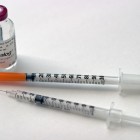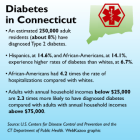Disparities
Low-Income Diabetics Paying High Price For Insulin
|
The high cost of insulin, which has risen by triple-digit percentages in the last five years, is endangering the lives of many diabetics who can’t afford the price tag, say Connecticut physicians who treat diabetics. The doctors say that the out-of-pocket costs for insulin, ranging from $25 to upwards of $600 a month, depending on insurance coverage, are forcing many of their low-income patients to choose between treatment and paying their bills. “Some of my patients have to make the choice between rent or insulin,” said Dr. Bismruta Misra, an endocrinologist with the Stamford Health Medical Group. “So they spread out taking insulin [injecting it less frequently than a doctor has prescribed] or don’t take it.”
Experts and recent studies point to drug companies’ long-standing patents and the lack of generic or “biosimilar” insulin as key reasons why the drug is so expensive. A study by Philip Clarke, a professor of health economics at the University of Melbourne in Australia, reported that the price of insulin has tripled from 2002-2013.

